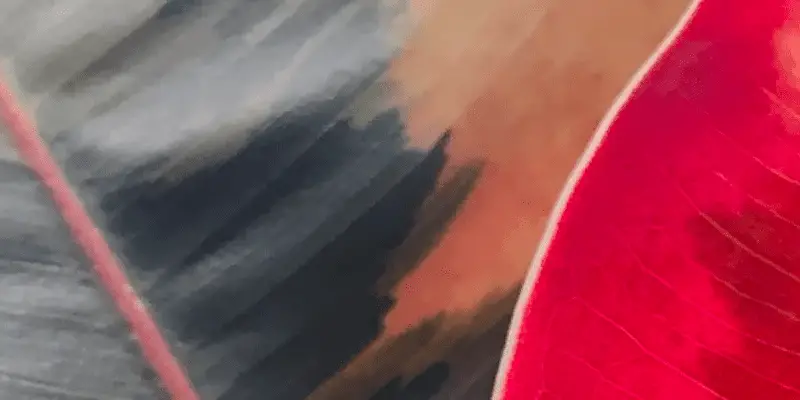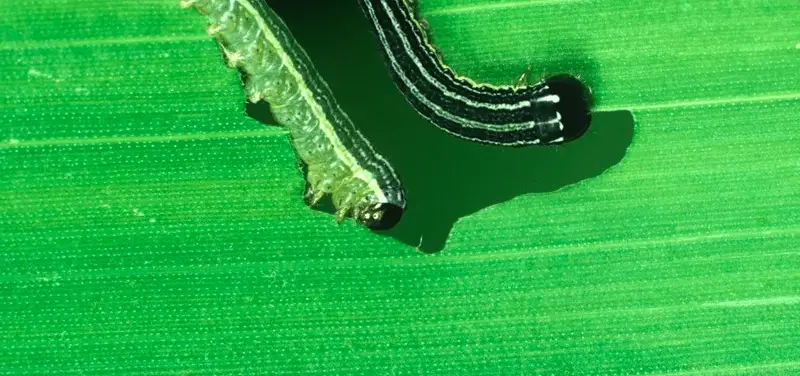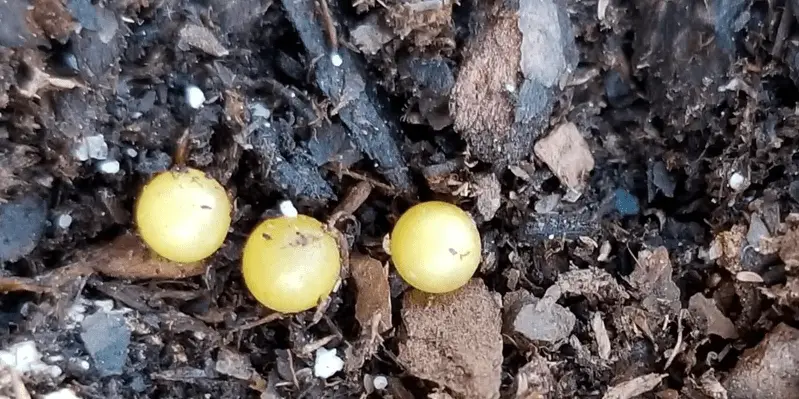You’re out in your garden, enjoying the beautiful weather and all of Mother Nature’s gifts. All of a sudden you notice something green crawling on the ground near your feet. What could it be? Is it dangerous?
Well, relax! It’s probably just one of the many common bugs that can be found in any garden – including yours! Here are some quick facts about 10 such creatures:
Top 10 Green Bugs Commonly Found in a Garden
- Grasshoppers
- Katydids
- Praying Mantis
- Aphids
- Green Stink Bugs
- Cucumber Beetles
- Tomato Worms
- Glorious Beetles
- Green Lacewing
- Ambush Bugs
1) Grasshoppers
Grasshoppers are the most common green bugs that you may find in your garden. They are often confused with katydids, but grasshoppers have larger hind legs and antennae which extend outward while the mouth is located at the bottom of their head. If disturbed or frightened, they can jump great distances to get away from danger.
- Their long back legs allow them to leap up to 20 times their own height!
- They eat leaves off plants both above ground level as well as on the ground below
- There are over 12,000 species of grasshoppers throughout the world today!
You can get rid of grasshoppers by using beneficial nematodes or ladybugs.
2) Katydids
Katydids are very similar to grasshoppers, but they have much smaller heads and longer antennae than their green cousins. Katydids also tend to be more of a brownish color rather than bright green like most other bugs common in gardens. They eat leaves off plants just the same as grasshoppers do – by eating both above ground level vegetation as well as lower plant life on the floor below them!
- They can fly short distances if needed (usually less than 100 feet) but usually will jump away instead
- There are over 6000 species of katydids living throughout the world today!
- Crickets make up the vast majority of the katydid population
3) Praying Mantis
The praying mantis is another green bug that can be commonly found in gardens throughout the world. They are actually not a type of grasshopper or katydid but have many similar characteristics to those bugs as well, such as their largemouth and long antennae at the top of their head.
However, what really distinguishes them from other common garden pests – besides size! – is the way these insects eat: by capturing prey using its front legs first before eating it whole with its powerful mandibles (jaws). The female praying mantis will usually eat her mate after mating if he doesn’t get away quickly enough! Praying Mantises love to dine on other bugs common to gardens, such as the tomato worm.
- They are usually green but can change color if needed – even turning pink or yellow! It’s believed that this is a defense mechanism used to mimic flowers in order to not be noticed by predators looking for an easy meal. The more scared they feel, the darker their color becomes!
4) Aphids
Aphid infestations are often one of the worst problems gardeners have to deal with every year because these little guys reproduce at very high rates and will eat everything from your plants’ leaves right down to their roots during their short lives.
Aphids are also known for being carriers of some pretty terrible diseases that can affect your plants, including viruses and even root rot!
- They live from birth to death in about a week – so if you see them, they have been reproducing at high rates and will continue doing so until something gets rid of them or their food source is gone!
- There are over 4000 species of aphids around the world today – many of which cause problems for plants by eating away at leaves both on the ground level as well as up above while leaving behind sticky honeydew residue on foliage.
5) Cucumber Beetles
Those green bugs may look like ladybugs but they actually belong to a different family entirely (despite having similar colorings and markings).
Cucumber Beetles can be found in gardens throughout the world. They love to eat plants, which is why they are often considered pests! The larvae of cucumber beetles feed on roots while the adults will feast on foliage up above as well as fruits such as tomatoes if hungry enough.
Cucumber Beetle Facts:
- The female cucumber beetle lays her eggs in the soil at a depth about ¼” below where she is standing when doing so – but only after having been fertilized by a male first! This ensures that there’s no wasted effort between genders during reproduction because everything has already taken place before laying their eggs down into the earth for protection.
6) Green Stink Bugs
The green stink bug is another one of those common garden pests that can be found throughout the world. Like some other bugs on this list, they are excellent at hiding in vegetation and will feed off fruits, vegetables, corn – anything edible really!
- They have no problem flying away if needed or running very fast to escape predators looking for an easy meal when threatened. If cornered though, their defense mechanism is to lift up its wings so that it looks larger than life (like a shield) while releasing its stinky odor caused by chemicals stored in glands near its abdomen.
7) Tomato Worms
Tomato worms, also known as hornworms, are commonly found in gardens belonging to gardeners throughout the world – especially when tomatoes have been planted! These large green bugs can grow up to a whopping six inches long and eat voraciously during their short lives.
They feast on the foliage of all kinds but particularly enjoy tomato plants because they love being able to hide from predators among the leaves while having plenty of food available nearby for fuel.
- The larvae stage is usually where you will find them most often hiding both day and night until fully grown before becoming moths that fly away. The females lay eggs very close together so there’s no wasted effort or time between laying each individual egg just after mating has taken place.
8) Glorious Beetles
Glorious beetles are another type of green bug that is actually more closely related to ladybugs than it is to cucumber beetles. They have an appearance similar to the former, which explains why they are often mistaken for one another!
These bugs eat various plants and plant matter year-round but particularly enjoy feasting on leaves during their short lives – consuming between twenty and fifty per day depending upon how hungry they become throughout this process.:
- They can fly away if needed or run very fast in order to escape predators looking for an easy meal when threatened. If cornered though, their defense mechanism is releasing a pungent odor caused by chemicals stored in glands near its abdomen rather than lifting up its wings.
9) Green Lacewing
Green lacewings are close relatives of the ladybug and have an appearance similar to it as well. Unlike many other common garden bugs, they eat aphids (greenflies) instead of plant matter like most others on this list do – making them a helpful bug for any gardener looking to keep their plants healthy!
The larvae stage is where these green bugs live before becoming adults that fly away with wings once fully grown. These insects love eating up to one hundred aphids per day but unfortunately can’t control how many there actually are in your garden due to their size limiting what they’re able to catch at one time.
- Green lacewings have been used for centuries to help control pest aphids and other insects.
10) Ambush Bugs
Ambush bugs also known as thread-legged bugs, love eating other insects but will do so by using a surprise attack rather than chasing them down like many others on the list.
They don’t have wings and instead crawl around plants looking for their next victim before quickly jumping out of hiding to bite into it with powerful mouthparts that inject venom to paralyze or kill whatever they happen upon.
These green garden pests are very proficient at blending in among foliage because of their mottled brownish coloration making it difficult for predators – especially birds – to spot them easily from above!
- Female ambush bugs lay one hundred and fifty eggs all at once after mating taken place which hatches within only seven days. The eggs are usually laid on the underside of leaves where they’ll remain as larvae for forty-five to sixty days before becoming adults that fly away with wings once fully grown!
Conclusion
In conclusion, there are many different types of green bugs out there that can be found in a garden throughout the world. Of course, not all of them will cause damage to your plants but it is important to know what they look like so you don’t accidentally harm beneficial insects instead!
By knowing more about each individual bug and its eating habits – you’ll have an easier time keeping these helpful creatures around while still getting rid of any harmful ones causing problems for your garden because you won’t need to guess when trying to find their hiding places among foliage before spraying with pesticides meant for other species.
Green bugs come in various shapes and sizes depending upon which type they happen to be but mostly share the same coloration making it easy for predators looking for quick meals (including you) to spot them from a distance away.
Tim is an avid gardener from the UK. He was the founder of PlantCarer.com from 2021 to Sep 2023. He sold PlantCarer.com to Aaron. He has since started his own business called Seed To Supper, which provides new gardeners all the materials you need in a box (pots, seeds, compost and instructions) to grow your own delicious and nutritious vegetables and herbs from start to finish – no garden required.









0 Comments